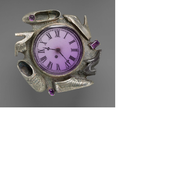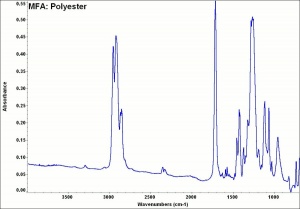Polyester resin
Description
A thermoplastic or thermosetting resin made by the reaction of an ester of dihydric alcohol and terephthalic acid. Polyester resins were first discovered by the Swedish chemist Berzelius in 1847. Thermosetting polyesters are cross-linked alkyd resins that are used as paints and in molded or cast products. Thermoplastic polyesters are linear compounds that are used in fibers and films. One type, polyethylene terephthalate (PET) was first developed by English chemists, J. R. Whinfield and J.T. Dickson, in 1941. PET is used to make Mylar® and other strong moisture-resistant films as well as to make Dacron® (and Terylene®), an important textile fiber. Polybutylene terephthalate (PBT), is mainly used as a molding compound. When catalyzed, polyesters can harden at room temperature and pressure with very little shrinkage to produce a clear, colorless fiber, block or film. They are often used for encapsulating and embedding samples and objects.
Synonyms and Related Terms
PER; résine polyester (Fr.); resina poliestere (It.); resina de poliéster (Port.); Polyester (Deut.); poliéster (Esp.); polyester (Sven.); poliestry (Pol.)
Examples: Dacron® [DuPont]; Mylar® [DuPont Teijin]; Melinex® [DuPont Teijin]; Bio-Plastic®; Caroplastic; Castolite; Fortrel; Vestopal; Terylene [ICI]; Tergal; Tetlon; Palatal; Leguval [Bayer]; Kodel® [Eastman Chemical]; Paraplex [Resinous Products and Chemicals]
Other Properties
Resistant to cold acids, weak alkalis, bleach and most organic solvents. Degrades in strong alkalis, strong hot acids, cresol.
| Melting Point | 238-290 |
|---|---|
| Density | 1.32-1.38 |
| Refractive Index | range: 1.54 -1.72 |
Hazards and Safety
Difficult to ignite. Burns with a shiny, yellow-orange, sooty flame. Self-extinguishing
Comparisons
General Characteristics of Polymers
Physical Properties for Selected Thermoset Resins
Physical Properties for Selected Thermoplastic Resins
Physical Properties for Selected Thermoplastic Resins
Sources Checked for Data in Record
- G.S.Brady, Materials Handbook, McGraw-Hill Book Co., New York, 1971 Comment: p.624
- Ralph Mayer, A Dictionary of Art Terms and Techniques, Harper and Row Publishers, New York, 1969 (also 1945 printing)
- Theodore J. Reinhart, 'Glossary of Terms', Engineered Plastics, ASM International, 1988
- Marjorie Shelley, The Care and Handling of Art Objects, The Metropolitan Museum, New York, 1987
- Richard S. Lewis, Hawley's Condensed Chemical Dictionary, Van Nostrand Reinhold, New York, 10th ed., 1993
- Hermann Kuhn, Conservation and Restoration of Works of Art and Antiquities, Butterworths, London, 1986
- Michael McCann, Artist Beware, Watson-Guptill Publications, New York City, 1979
- Dictionary of Building Preservation, Ward Bucher, ed., John Wiley & Sons, Inc., New York City, 1996
- Pam Hatchfield, Pollutants in the Museum Environment, Archetype Press, London, 2002
- Marjory L. Joseph, Introductory Textile Science, Holt, Rinehart and Winston, Fort Worth, TX, 1986
- Thomas C. Jester (ed.), Twentieth-Century Building Materials, McGraw-Hill Companies, Washington DC, 1995
- Identification of Textile Materials, The Textile Institute, Manchester, England, 1985
- External source or communication Comment: S.Blank Studies in Conservation 35:53-63, 1990---used as a lacquer since 1933..commercially cast or used as fiber until 1941.
- M.Kaufman, The First Century of Plastics, The Plastics and Rubber Institute, London, 1963
- F. Kidd, Brushmaking Materials, Bristish Brush Manufacturers, London, 1957 Comment: p. 133
- Wikipedia, the free encyclopedia, at http://www.wikipedia.com Comment: http://en.wikipedia.org/wiki/Polyester (Accessed Jan. 6, 2006)


